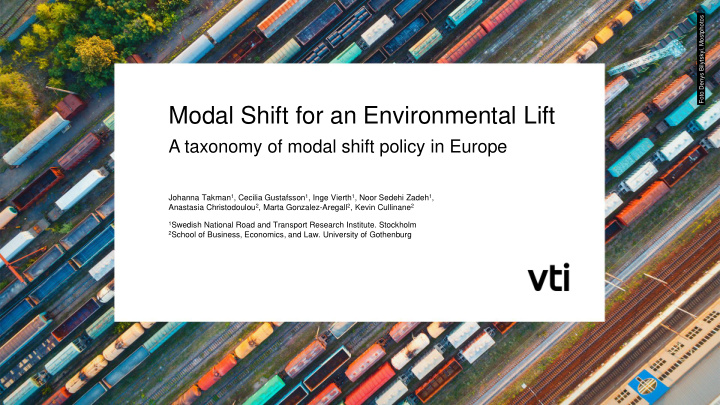



Foto Denys Bilytskyi, Mostphotos Modal Shift for an Environmental Lift A taxonomy of modal shift policy in Europe Johanna Takman 1 , Cecilia Gustafsson 1 , Inge Vierth 1 , Noor Sedehi Zadeh 1 , Anastasia Christodoulou 2 , Marta Gonzalez-Aregall 2 , Kevin Cullinane 2 1 Swedish National Road and Transport Research Institute. Stockholm 2 School of Business, Economics, and Law. University of Gothenburg
Foto Enrapture Captivating, Unsplash OBJECTIVE AND BACKGROUND
Foto Adrian Bar, Unsplash OBJECTIVE What potential does modal shift have to contribute to the fulfilment of the Swedish climate and environmental objectives? Including the desired reduction of CO2, NOx, SOx, PM2.5 and noise. Which are the most effective policies to achieve a modal shift? 1. Which policy instruments have the goal to shift goods from road to less environmentally damaging modes? This study 2. Which policies would be most effective in a Swedish context? 3. Climate and environmental effects Next study
Why care about a modal shift? GHG GHG-emiss emissions ions fr from domest om domestic Sw ic Swedish goods edish goods tr transpor ansport Kt CO2 ekv. Millions of tonne kilometres (tkm) 8000 120000 6000 90000 4000 60000 2000 30000 0 0 1990 1995 2000 2005 2010 2015 2020 2025 2030 Heavy trucks, CO2 Light trucks, CO2 Waterborne transport, CO2 (domestic) Rail, CO2 Freight transport segments, CO2 target Freight transport segments, tkm Freight transport segments, prognosis tkm
Why care about a modal shift? Ton onne ne kilometr kilometres es an and d GH GHG-emiss emissions ions by by mod mode, e, 20 2017 17 95,01% 100% ~ 41% of domestic tonne kilometres with Swedish heavy drucks are > 300km 80% 64,72% 60% 40% 26,59% 20% 8,69% 3,80% 1,19% 0% Heavy trucks Rail Waterborne transport (domestic) Tonne kilometres CO2
Foto Chuttersnap, Unsplash MODAL SPLIT OVER TIME IN SWEDEN (SHARE OF TONNE KILOMETRES) 100% 80% 60% 40% 20% 0% 2010 2011 2012 2013 2014 2015 2016 2017 Heavy trucks Rail Waterborne transport
Foto Adrian Bar, Unsplash WHAT HAVE WE DONE IN THE PROJECT SO FAR? Literature review Workshop Database Analysing policies
Foto Enrapture Captivating, Unsplash BARRIERS TO MODAL SHIFT
Barriers to modal shift Rail In general On Reliability Flexibility time! Poorly maintained infrastructure Coordination STOP Capacity limits Low demand-side interest Water Ineffective regulation Prices / Costs in ports Tax and fee disincentives Ineffectiveness in ports Lead times
Foto Chuttersnap, Unsplash MODE CHOICE Most important factors Other comments: when choosing mode: Generally freight forwarders Costs / prices or producers that purchase transport services. Reliability / Precision You do not “choose” Flexibility transport mode but rather request a transport service. Lead time Firms do not reconsider their Other important factors: choices very often. Simplicity Habits Environment
Foto Enrapture Captivating, Unsplash TAXONOMY OF POLICY INSTRUMENTS
Data collection Past, present and planned policies in Europe Several categories including: • Type of policy • Geographical level • Targeted mode • Results of policy • Effectiveness of policy
Some examples of policy instruments Economic Informative Infrastructure Research Administrative Legislations Taxes Information Technique testing Maintenance campaigns Environmental Subsidies Development classifications Eco-labelling Infrastructure investments Technical requirements
Taxonomy of policy instruments Majority EU-grants and local port Many local port initiatives infrastructure measures Other policies usually national or regional Economic policy mostly grants (EU) N = 178
Taxonomy of policy instruments The majority of policies only Most policies target a shift to rail. target one mode N = 178
Taxonomy of policy instruments Available policy evaluations Lack of quantified targets 200 154 Lack of evaluations 160 120 Available evaluations mainly concern economic policies at 80 national or EU level 40 13 6 5 → Key data unavailable 0 Qualitative Quantitative Qualitative and Not available Quantitative N = 178
Taxonomy of policy instruments Most evaluation reports do not classify the Among succesful policies are different types of evaluated policy as succesful/efficient eco bonus systems and grants Lack of applications common factor for failure Is the policy described as Succesrate of policy succesful/efficient? 20 14 16 12 16 12 10 12 8 6 6 6 8 6 4 4 2 1 1 0 0 No Yes Yes and no High Low Low/medium No target N = 24
Foto Enrapture Captivating, Unsplash CONCLUSIONS AND FURTHER RESEARCH
Foto Chuttersnap, Unsplash CONCLUSIONS Most policy instruments are economic, but all decision factors matter → Need for policy mix Reliability, badly maintained infrastructure and capacity limits are main barriers for a modal shift to rail → Support to infrastructure investments. High costs and ineffectiveness in ports are main barriers for a modal shift to waterborne transports. → Target the costs in ports. Few ex post-analysis of policies and a lack of quantified targets. Lack of interest is an important explanatory variable for failure.
Foto Chuttersnap, Unsplash FURTHER STUDIES Continue analysis of effective policies Environmental effects from policy scenarios Recommendation for most effective policy mix
Foto Denys Bilytskyi, Mostphotos Thank you very much! Any comments or questions?
Recommend
More recommend